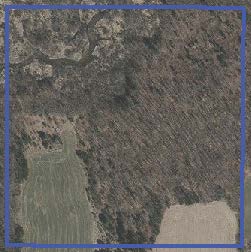Does your tax bill tell you what it needs to? The Answer is NO.
Published March 2018

To help our legislators, and all of us who own woodland, better understand the tax inequities our forest lands face, the WAFO has begun work to see that our property tax bills present the information we need.
In a recent meeting with Department of Revenue officials, WAFO pointed out that the property tax bills we receive in December do not present us with information currently required under state law. It’s no wonder people have a hard time understanding how the tax system works. This needs to be fixed.
To better understand, let’s take a look at an example of a 40 acre parcel (at right) and the tax bill (link below) the landowner received.
After inquiring about more detailed property tax classifications, we learned that the assessor had broken down this parcel into 4 different classifications::
- 6 acres of agricultural land (taxed at use-value rates),
- 3 acres of undeveloped land (assessed at 50% of fair market value)
- 15 acres of agricultural forest (assessed at 50% of fair market value)
- Also shown are 16 acres of land enrolled in the Managed Forest Law (MFL) that are taxed at a separate rate but still must be assessed appropriately. Unfortunately even this more detailed information doesn’t tell you how these 16 acres are classified.
| 2017 Valuations | Values Last Changed on September 24, 2014 | |||
|---|---|---|---|---|
| Class and Description | Acres | Land | Improvement | Total |
| G4-AGRICULTURAL | 6.000 | 700.00 | 0.00 | 700.00 |
| G5-UNDEVELOPED | 3.000 | 2,500.00 | 0.00 | 2,500.00 |
| G5M-AGRICULTURAL FOREST | 15.000 | 26,300.00 | 0.00 | 26,300.00 |
| W8-MFL CLOSED PRE 2005 | 16.000 | 40,000.00 | 0.00 | 40,000.00 |
Here is the tax bill the landowner received.
In the first line of the highlighted boxes (shown in the detail below), there is shown an “Assessed Value Land” of $29,500 and a “Total Assessed Value” of $29,500. On the second line, the letters PFC/MFL are shown followed by a “Total Assessed Value” of $40,000.
In the lower box all you are shown is “See Reverse, Use Value Assessment.”
| Assessed Value Land | Ass'd. Value Improvements | Total Assessed Value |
|---|---|---|
| 29,500 | 29,500 | |
| PFC/MFL | 40,000 | |
| Est. Fair Mkt. Land | Est. Fair Mkt. Improvements | Total Est. Fair Mkt. |
| See Reverse, Use Value Assessment | ||
Does this bill show you the assessed and the estimated fair market value of this 40 acre parcel, as required by law? No it does not.
While the law specifically exempts showing the fair market value of agriculturally classified land it does require that the fair market value of the other classified uses be shown. Why aren’t the fair market values of agricultural land shown? We don’t know.
In this example, without more detailed information, the landowner is at a loss to know whether or not the assessor has correctly broken down the entire parcel into its different classifications and correctly valued the land for assessment and tax purposes.
Quiz time!
QUESTION: If you are this landowner, why should you be contacting your assessor to get a potential problem corrected?
ANSWER: In this example it appears the assessor has correctly classified the 15 acres of the woods as “Agricultural Forest” and valued it at $29,500 which is close to 50% of what fair market value would be. On the 16 acres of land in the MFL, he has a much higher value of $40,000 assigned to these lands. Did he mistakenly value this land as “Productive Forest”? If yes, this mistake would not affect this year’s tax bill, but because MFL has a flat rate tax, if left uncorrected, it would double any MFL withdrawal penalties if the land was removed before the MFL contract expired.
BOTTOM LINE: While WAFO has begun the process to get our tax bills re-designed to meet the law, there is no way to know if or how quickly this might happen. You can help by showing your legislator your tax bill, along with the law excerpt, and tell them you would hope this problem can be corrected before tax bills come out in December.
A great resource to help you learn more about how lands are classified, read the Wisconsin Alliance of Forest Owner’s Landowner Guide.
